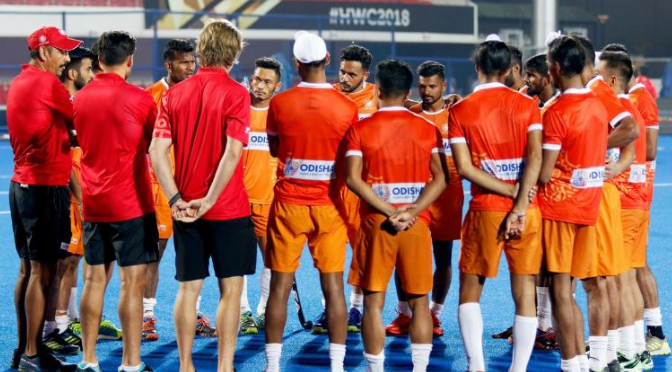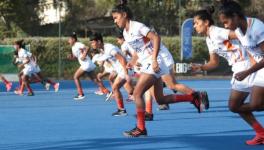Hockey Makes U-Turn in Evolution, Kicks Back the Kicking Back

Indian hockey team coach Harendra Singh (left) employed the kicking back twice during the FIH Men’s Hockey World Cup, and without much success as far as goals or opening up play is concerned (Pic: FIH).
36 matches. 157 goals. 4.36 goals a game. Even before the FIH Men’s Hockey World Cup was over, with fireworks and a Belgian victory, most analysts agreed that this had been one of the most technically sound, tactically brilliant, speed loaded tournaments played in recent history. More field goals, more matches, more everything. The hockey party had taken the old bar, broken it and installed a gravity defying trampoline jump instead. Where to next everyone wondered.
Among the most common tactical stories that emerged from the tournament, the death of the drag flick occupied top position. Data collected through the pool stages showed that of the 167 penalty corners awarded, a mere 40 resulted in goals. A staggeringly low return rate of 23.95%.The numbers, the statistics and the failure of Dutch expert Mink van Der Weerden (who perhaps single handedly made sure the numbers justified the stories) all pointed towards a new era of field hockey, a throwback to a bygone era.
A second narrative surrounded the ‘kicking back’. This narrative’s roots of course took hold the moment Harendra Singh, coach of the Indian hockey team, bravely proclaimed that he wanted to take off goalkeeper PR Sreejesh with eight minutes left on the clock and introduce an eleventh field player in during their last pool match against Canada. For the record, he didn’t. He took off Sreejesh with two minutes left, and the score a comfortable 5-1. If he had pulled off Sreejesh when he said he would, with the score a not so comfortable 3-1, heads may have been in danger of rolling. For a few days, the ‘kicking back’ was in vogue, and virtually everyone involved with the game were discussing the merits of the system.
Video | FIH Men's Hockey World Cup: The Story of the Tournament
But let’s step back here a bit to discuss what a kicking back actually is. Contrary to popular culture’s association with the term, the kicking back in hockey is not a protest against the system or a resistance against the establishment. A kicking back, in hockey, is what it says it is: a back (defender) who is allowed to kick the ball away. She/He is a replacement for the goalkeeper, wears a different coloured shirt, and more often than not, is the last resort in a doomed cause.
Consider three (of several) instances that the teams brought on kicking backs at the World Cup in Bhubaneswar. Belgium, against India, in the pool stage with the score locked at 2-2 and Belgium in desperate need of a winner to avoid the crossover playoff (in retrospect, they may not have brought him on). India, against the Netherlands, when down by a goal with minutes to play in the quarterfinal (to no avail). Australia, against the Netherlands, when 1-2 down in the dying minutes of the semifinal (the Aussies being Aussies, they obviously got the equaliser).
The kicking back is a dying man’s final resort, the last throw of the dice, the delaying of the death knell with an abstract confession.
“It doesn’t need to be,” says Siegfried Aikman, coach of the Japan team which won gold at the Asian Games earlier this year. Aikman, a coach who earned his merits coaching other coaches for the International Hockey Federation (FIH), is a firm believer in tactical innovation not to suit the gameplay but rather to influence it.
Also Read | Hockey India: Ruling With an Iron Fist
“Most coaches use the kicking back as a desperate measure simply because they cannot risk their careers by trying something bolder. Imagine if Harendra had introduced a kicking back earlier and India had conceded. You guys would have eviscerated him,” Aikman laughs.
Aikman insists that as a coach of the women’s team HC Hertogenbosch in the Dutch league, he introduced the kicking back much earlier in games, sometimes at the end of each period, and often when his team were holding the possession, but were unable to convert against a team packing the defensive areas.
In the Asian Games final against Malaysia, Aikman used this knowledge of kicking back operatives to counter his Malaysian counterpart. “When Malaysia introduced a kicking back in the final minutes of the game, I countered by bringing in an extra striker. I knew that committing three strikers was a risk, but it also meant that their kicking back was rendered useless, he would not be able to go as far up as the coach wanted, simply because of the threat of a vertical counter.”
Aikman’s biggest lament about the tactic though was about the way it was often used. In desperation. He understands it, but that doesn’t colour his condemnation. “With the kicking back, there is a need to educate kicking backs to be able to play as goalkeepers too. Teams use the kicking back as a desperation tactic, rarely with purpose and planning. That needs to change. If kicking backs can be given more responsibility and introduced more frequently…” he shrugs.
Also Read | Hockey 2024: FIH’s Global Expansion Dreams and the Turf Realities
For now, though, those plans can be canned. Just after the packers and movers took the World Cup party away from Bhubaneswar, the FIH released their amended ‘Rules of Hockey’ which will come into force from January 1, 2019.
One of those amendments pertains to the kicking back. In short, it abolishes the position. The rule now states that teams can either start with 11 field players, or 10 field players and a goalkeeper. If they decide to start with 11 field players then none of them have goalkeeping privileges. The FIH have suggested this recommendation considering the safety of players often playing in kicking back positions and also to remove the confusion that surrounds the position itself.
And so, with this amendment (another throwback), a 12 year impasse has finally come to an end. At first look, it seems strange and terribly medieval to actually turn back the clock to the days of tactical past. But a closer analysis may reveal something deeper.
The truth about the kicking back is this: he really needs to kick, has to kick, or kick at all. Most players who are introduced to replace the goalkeeper, have no idea what it takes to be a goalkeeper. They don’t know the body positioning, the movement, or even the dimensions of the goal they are to defend accurately. Case in point is poor Harmanpreet SIngh, the kicking back introduced in the Netherlands game against India. Within a minute of his introduction, India conceded a PC, and Harmanpreet when informed by his teammates that he would be ‘playing goalkeeper’ looked, let’s say, mildly shocked.
Video | The Business End of the FIH Men's Hockey World Cup
Teams that bring on kicking backs do so against teams that are defending with all their might as if against the Kraken — backs to the wall so to speak. Teams rarely concede with kicking backs in play. It is a tactical move designed to bring about more attacking play, but actually it is a tactical move that mostly brings about more sideways passing. The introduction of an eleventh field player does little to aid movement, or create space in an already crowded 25-yard area.
In football, the goalkeeper has evolved from being a shot stopper to a sweeper to ball player, simply because of the evolution of Gegenpressing. It is a reaction to the high pressing strategy employed by most elite sides today. High pressing in an opponent's box usually means two players are pressuring a defender and a goalkeeper into a mistake. A ball playing goalkeeper negates the press by launching accurate long balls, or forward passes easily, since the opposition, technically, is now devoid of two players to fill up defensive space.
In an already crowded pitch where the high press is not so fashion as it is orthodoxy, a ball playing goalkeeper can do little but hold up play.
In conversations, Aikman had suggested he was working to teach field players goalkeeping movements, and the goalkeepers field player dynamics. But now, that is waste. In many ways, the introduction of this rule actually forces coaches to reinvent drilling methods for the eleventh field player.
A simplistic version would involve introducing the eleventh player with the specific agenda of drawing opposition players deeper into their own half. The lack of a goalkeeper is after all as inviting a prospect as a free for all buffet. Committing players forward will open up space.
Also Read | The Alchemy of Desire: Belgium’s Decade Long Journey to the Pinnacle of Hockey
A secondary evolution may involve what Aikman suggests, the evolution of the goalkeeper as an actual hockey player (no disrespect all of you goalkeepers). Paul Bundy, Canada’s coach often drills in his goalkeepers the need to consider their position the ‘last defender’. In the circle, Canada’s goalkeeper David Carter would more often than not, be actually marking an opposition striker than just protecting the frame of his own goal. In a zonal marking system, that released a player for Canada to use in case they managed to turn the ball over and launch a counter.
The FIH’s faults may be many, but in its removal of the kicking back, few will protest. If anything, this gives a new life to equipment manufacturers, as much as it does coaches. Turning the goalkeeper’s current Transformer suit, into a fluid Robocop’s, may be its best job yet. The more to play the ball with.
Get the latest reports & analysis with people's perspective on Protests, movements & deep analytical videos, discussions of the current affairs in your Telegram app. Subscribe to NewsClick's Telegram channel & get Real-Time updates on stories, as they get published on our website.
























